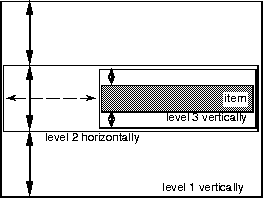


Next: Meta-Level Techniques for Up: No Title Previous: User-Defined Layout Schemes



Next: Meta-Level Techniques
for
Up: No Title
Previous: User-Defined Layout
Schemes
The important features of our basic box layout algorithm have already been explained in the previous sections. This formalism provides the user with a fast and flexible layout algorithm, which is also easy to understand and anticipate. In order to keep this formalism simple, we decided to restrict the dependencies between boxes and fillers, i.e. their mutual influence on size and position of graphical objects. Boxes may be arbitrarily nested, but only fillers on the same box level compete for the available space. Figure 7 exemplifies this feature.

Figure 7: Schematic representation of nested boxes.
Arrows represent fillers.
The (vertical) fillers of level 1 are independent of the (vertical) fillers of level 3. This restriction reduces considerably the computational complexity of the layout algorithm. Another advantage is that the semantics of constrained fillers are easy to comprehend by the user. Even this scheme requires a simple relaxation algorithm for constraint satisfaction. Figure 8 illustrates our algorithm.

Figure 8: Water jugs modeling fillers.
Each water jug models a filler having a minimal and maximal
expansion value. The current extension of a filler corresponds to the water
level of a jug. The total space available to fillers is modeled by an external
water reservoir with capacity
 . The extension of a filler is
computed by the following steps:
. The extension of a filler is
computed by the following steps:
 . It is guaranteed that every water
jug j is at least filled to its minimum
. It is guaranteed that every water
jug j is at least filled to its minimum
 . In case of an additional demand
for water, which cannot be supplied by an empty water reservoir1, this demand is satisfied by a
``water pipe''. If there is any water
. In case of an additional demand
for water, which cannot be supplied by an empty water reservoir1, this demand is satisfied by a
``water pipe''. If there is any water
 in the reservoir left, the
remainder of this water is distributed according to the following steps.
in the reservoir left, the
remainder of this water is distributed according to the following steps.
 of the reservoir (be
of the reservoir (be  the number of
water jugs in the ith iteration). Step 1 may have caused for different
water levels of the jugs. Therefore, every jug is filled to a common minimal
level
the number of
water jugs in the ith iteration). Step 1 may have caused for different
water levels of the jugs. Therefore, every jug is filled to a common minimal
level

 or its maximum
or its maximum
 . The amount of water exceeding
either
. The amount of water exceeding
either  or
or
 is returned to the reservoir. A jug
which has reached its maximal level becomes inactive (
is returned to the reservoir. A jug
which has reached its maximal level becomes inactive ( ).
).
 ;
i=i+1) provided the water reservoir is not empty and there is at least
one jug j left whose water level is below maxj. This
algorithm terminates when all jugs are inactive (
;
i=i+1) provided the water reservoir is not empty and there is at least
one jug j left whose water level is below maxj. This
algorithm terminates when all jugs are inactive ( ) or the water reservoir is empty.
) or the water reservoir is empty.
The termination of this algorithm is guaranteed since each cycle either makes
one jug inactive or removes water from the reservoir. If no jug becomes inactive
at least one jug is filled to the level
 . The computation of the relaxation
process uses integer arithmetic. Therefore, rounding errors are summed up and as
final step this sum is rounded and added to the last filler.3
. The computation of the relaxation
process uses integer arithmetic. Therefore, rounding errors are summed up and as
final step this sum is rounded and added to the last filler.3



Next: Meta-Level Techniques
for
Up: No Title
Previous: User-Defined Layout
Schemes